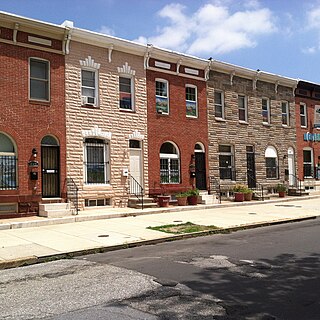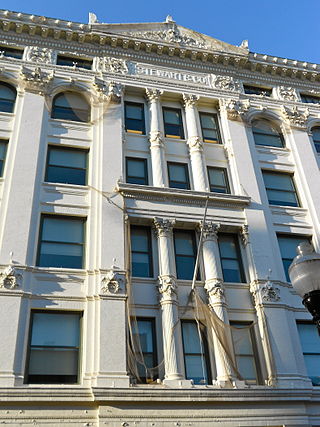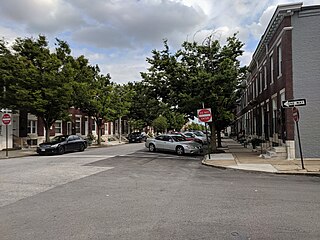
Brooklyn Park is a census-designated place (CDP) in Anne Arundel County, Maryland, United States. The population was 14,373 at the 2010 census.

Essex is an unincorporated community and census-designated place in Baltimore County, Maryland, United States. Essex history dates to 1909. The population was 40,505 in the 2020 census, up from 39,262 in the 2010 census.

Pikesville is a census-designated place (CDP) in Baltimore County, Maryland, United States. Pikesville is just northwest of the Baltimore city limits. It is the northwestern suburb closest to Baltimore.

Middle East is a neighborhood in the heart of East Baltimore, Maryland.

Howard Street is a major north–south street through the central part of the city of Baltimore, Maryland. About 2+1⁄2 miles (4 km) long, the street begins at the north end of I-395 near Oriole Park at Camden Yards and ends near Johns Hopkins University, where it splits. To the right, it becomes Art Museum Drive, the one-block home of the Baltimore Museum of Art. To the left, it becomes San Martin Drive, which winds road along the western perimeter of the Johns Hopkins University campus and ends at University Parkway. Howard Street is named in honor of former Maryland governor John Eager Howard. Two other streets in Baltimore, John and Eager Streets, are also named after him.

Chase is an unincorporated community in eastern Baltimore County, Maryland, United States.

Brooklyn is one of the southernmost neighborhoods in Baltimore, Maryland. It is located near Anne Arundel County along Governor Ritchie Highway which is also Maryland Route 2. Its main roads are South Hanover Street,, Potee Street, and East Patapsco Avenue, Sixth Street, Tenth Street, and West Bay Avenue which borders the neighboring Curtis Bay community to the east, running through Bay Brook Park, which separates the two. South Hanover Street also serves as the dividing line between east–west streets in Brooklyn, as Charles Street does not exist here.

Medfield is a neighborhood located in north Baltimore, Maryland, United States of America. It is located to the north of the trendy Hampden neighborhood and south of affluent Roland Park neighborhood. Its unofficial boundaries are Coldspring Lane to the north; Jones Falls Expressway to the west; Falls Road/Hickory Avenue to the east; and West 41st Street to the south.

The Jones Falls is a 17.9-mile-long (28.8 km) stream in Maryland. It is impounded to create Lake Roland before running through the city of Baltimore and finally emptying into the Baltimore Inner Harbor.

The Bethlehem-Fairfield Shipyard of Baltimore, Maryland, was a shipyard in the United States from 1941 until 1945. Located on the south shore of the Middle Branch of the Patapsco River which serves as the Baltimore Harbor, it was owned by the Bethlehem Shipbuilding Company, created by the Bethlehem Steel Corporation of Bethlehem, Pennsylvania, which had operated a major waterfront steel mill outside Baltimore to the southeast at Sparrows Point, Maryland in Baltimore County since the 1880s.

Port Covington or Baltimore Peninsula is a neighborhood in Baltimore, Maryland.
Middle River is an estuary in Baltimore County, Maryland, located about 5 miles (8 km) east of the city of Baltimore. The estuary extends from the community of Middle River, north of the Martin Plaza Shopping Center, to the southeast for about 4 miles (6.4 km), to the Chesapeake Bay. The watershed area of Middle River is 12 square miles (31 km2), and includes Martin State Airport.
Baltimore Chrome Works was a chromium ore refinery with its headquarters and main factory located at Fells Point, Baltimore, USA. Isaac Tyson started mining chromite in the area around Baltimore in 1813 and built the Baltimore Chrome Works at Fells Point in 1845. The works became part of Mutual Chemical Company in 1908, and merged into Allied Chemical in 1954. The plant, which was rebuilt in 1951, employed 375 people at peak production.
Bread and Cheese Creek is a tributary of the Back River in Baltimore County, Maryland. The creek is 3.2 miles (5.1 km) long, with headwaters just east of the Baltimore city line. It flows east through Baltimore County before emptying into the Back River, which flows into the Chesapeake Bay. The watershed area of the creek is 1.85 square miles (4.8 km2).

Baltimore is the most populous city in the U.S. state of Maryland. With a population of 585,708 at the 2020 census, it is the 30th-most populous city in the United States. Baltimore was designated an independent city by the Constitution of Maryland in 1851, and is currently the most populous independent city in the nation. As of the 2020 census, the population of the Baltimore metropolitan area was estimated to be 2,838,327, making it the 20th-largest metropolitan area in the country. When combined with the larger Washington metropolitan area, the Washington–Baltimore combined statistical area (CSA) has a 2020 U.S. census population of 9,973,383, the third-largest in the country.

Hawkins Point is a neighborhood in the South District of Baltimore, located at the southern tip of the city between Curtis Bay (north) and the Anne Arundel County line (south) and Thoms Cove (east). Its land area covers 2.6 square miles (6.7 km2), and it had a population of 24 people according to the 2020 U.S. Census. The neighborhood is predominantly industrial.

Poppleton is a neighborhood in west Baltimore, Maryland. The neighborhood is bounded on the north by West Mulberry Street, on the south by West Baltimore Street, on the west by North Carey Street, and on the east by the Martin Luther King Jr. Boulevard. Previously, Poppleton was construed in a broader sense extending further south to West Pratt Street or Lombard Street, but today this area is commonly described as the separate neighborhood of Hollins Market.

Madison-Eastend is a neighborhood in the heart of East Baltimore, Maryland. Madison-Eastend occupies 66.7 acres of land north of Patterson Park and south of Amtrak's Northeast Corridor. The neighborhood is bounded by the neighborhoods of Ellwood Park and McElderry Park to the south, Milton-Montford to the west, Biddle Street to the north, and Orangeville to the east. The swath of land between Johns Hopkins Hospital and Frank C Bocek Park, which includes Madison-Eastend, is often referred to as the "Down the Hill" neighborhood by local residents.
Masonville was a residential community and suburban neighborhood of Baltimore, Maryland. Historically, the town was one of five neighboring communities sought and ultimately annexed by Baltimore City from Anne Arundel County in 1918. The town was razed in its entirety in the 1950s, to accommodate the expansion of the Baltimore & Ohio Railroad's Curtis Bay terminal.















